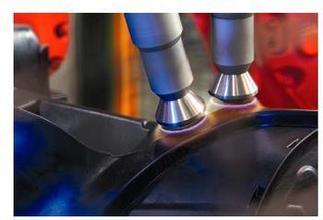

First, the film deformation causes and solutions:
the reason:
(1) temperature and humidity control failure
(2) Exposure temperature is too high
Solution:
(1) In general temperature control in 22 ± 2 ℃, humidity at 55% ± 5% RH.
(2) The use of cold light source or a cooling device of aerators and constantly changing backup negatives
Second, the negative distortion correction process method:
1, in the grasp of digital programming instrument technique, the first film and the drilling test panel mounted control, measure its length, width and two deformation amount of programming on the digital instrument according to the size of the amount of deformation lengthen or shorten holes with lengthen or shorten the post-drilling test holes to be co-deformation plate negatives, eliminating the complicated work of editing the film, to ensure the integrity and accuracy of the graphics. This method is referred to as the "Act to change the hole."
2, for the film with the ambient temperature and humidity changes and changes in physical phenomena, take a copy of the film before the film took the sealed bag, under working conditions hung in 4-8 hours, so that on the first copy of the film before the deformation, so that make a copy of the film after deformation is very small, said this law "hung in law."
3, for the simple circuit line width and spacing of large deformation irregular graphics, will be used to cut the film deformed portion control to copy the holes drilled test plate and then re-stitching, called this method "splicing method" .
4, using the test plate wells amplified into pads to heavy distortion circuit chip, to ensure a minimum ring width technical requirements, this method is called "pad overlap method."
5, the graph on the deformation of the film press scaled, re-map the plate, this method is called "mapping method."
6, using the camera to zoom in or out deformation pattern, called the law "a photographic method."
Third, the correlation method Notes:
1, splicing method:
Application: line less dense layers of the film negatives deformation inconsistent; the solder resist film and multilayer film power ground deformation is particularly applicable;
NA: high wire density, width and spacing of less than 0.2mm negatives;
Note: When splicing wires should be minimal injury, not to hurt the pads. After stitching copy revised version, should pay attention to the correctness of the connection relationship.
2, change the hole method:
Application: film layers deform the same. Line dense negatives this method is also applicable;
NA: negative uneven deformation, local deformation is particularly serious.
Note: With the programming device to lengthen or shorten the holes on the tolerance of the hole should be re-set.
3, hung in law:
Apply; yet deformed and prevent deformation of the film after the copy;
NA: deformed film.
Note: in ventilation and darkness (with security can be) linked to the film under ambient air, and avoid contamination. Ensure a consistent temperature and humidity hung in place and operating at.
4, the pad overlap method:
Applicable: Graphic lines less intensive, line width and spacing is greater than 0.30mm;
NA: in particular, the user demanding the appearance of the printed circuit board;
Note: Due to overlap after copy, pad oval. After overlapping copy, line, disk edge halos and deformation.
5, photographic method:
Application: film length and width direction deformation ratio consistent, inconvenient heavy drilling test board, applicable only silver film.
NA: negative longitudinal and transverse directions Deformation inconsistent.
Note: When photographic focus should be accurate to prevent distortion lines. More negatives loss, under normal circumstances, the need to obtain a satisfactory multiple debugging rear circuit pattern.
【 Go Back 】 【 Print 】 【 Close this window 】